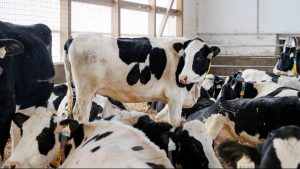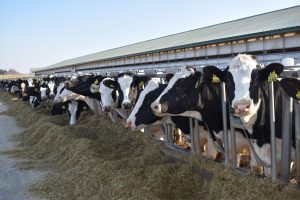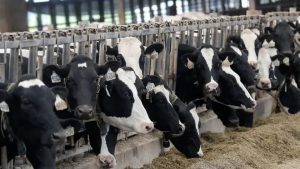
With bigger farms taking over a larger share of the market overall, many smaller dairy farms are also at a crossroads where they have to adapt or call it quits. From Milwaukee PBS and the Milwaukee Journal Sentinel, Rick Barret reports from Wisconsin.
Read the Full Transcript
Judy Woodruff:
President Biden held a virtual meeting with farmers today to discuss strategies to increase competition and combat rising prices for meat.
With bigger farms taking over a larger share of the market overall, many smaller dairy farms are also at a crossroads, where they have to adapt or call it quits.
From Milwaukee PBS and The Milwaukee Journal Sentinel, Rick Barrett investigates how some of the smaller farms in central Wisconsin are turning to technology to survive.
Rick Barrett:
Dennis and Suzie Roehl are third-generation dairy farmers in Clark County, Wisconsin. Like many others, they have gone through tough economic times.
Dennis Roehl, Dairy Farmer:
I think our biggest challenge on the farm other than financial is hired help. It’s getting people here. It’s really tough.
Rick Barrett:
And they worry whether their children will be able to or even want to take over the farm.
Suzie Roehl, Dairy Farmer:
It’s a hard job. It’s a lot of hours. It’s a lot of work, but there’s payoff to it. So, I think it’s — we have to adapt to the changes.
Rick Barrett:
Kristyn Nigon is the daughter of a farmer who’s trying to bring changes to the family farm. After studying dairy science in college, she quit an office job and returned home to help her father run the dairy operation, including milking 72 cows.
Kristyn Nigon, Dairy Farmer:
He’s willing to change with the times. He wants to try new things and is smart about it too.
And he does listen to his kids, so that helps. He has a very open mind, which is not easy for a lot of farmers, especially older farmers, to open up and let their kids come back and teach them something different.
Rick Barrett:
One thing different is a robotic feeder that was installed two years ago, at a cost of $21,000.
Man:
It’s pushing the feed up to them so they can reach it.
Rick Barrett:
And he can run 24 hours a day.
Man:
Twenty-four hours a day every two hours, yes, pushes the feed up to the cows. It’s a big labor saver.
Rick Barrett:
Robots are gaining ground in dairy farming. In addition to robotic feeders, there are also robotic milkers.
Max Malm, Dairy Farmer:
I have been doing it forever, but I still learn things every day.
Rick Barrett:
At his farm in Clark County, Max Malm has installed two robotic milkers for his 350 dairy cows.
Max Malm:
Cows have to be milked every single day. So, we looked at expanding, and you could hire people to milk, or you can choose robots.
Rick Barrett:
And how much would it cost for someone who would like to put in robots?
Max Malm:
They’re anywhere from $200,000 to $250,000 per robot. And then you have to build the barn around it. You’re looking at, for a two-robot barn, easily a million dollars.
Rick Barrett:
The Malms are part of about 1 percent of America’s 31,000 dairy farms that use robotic milkers to help cut labor costs.
While farmers have little say in milk prices, the U.S. Department of Agriculture says robots can provide up to nearly 30 percent cost savings in milking cows. And spending less time in the barn allows farmers to focus on other sources of income, like raising beef, alternative crops, even jobs off the farm, ultimately helping them remain profitable.
Global futurist Jack Uldrich agrees that dairy farmers have to invest in new ways of thinking, including technology.
Jack Uldrich, Global Futurist:
There are going to be manless tractors. There are going to be satellites looking down on your individual farm fields, identifying which crops are growing, which ones aren’t, and you are going to be able to apply the exact amount of water, the exact amount of pesticide, herbicide, whatever you need on it.
Rick Barrett:
Back at the Roehl farm, Dennis and Suzie decided it was time to install robotic milkers for their 500 cows.
Suzie Roehl:
I do think farming is going to continue, but I do think we have to change for our children to want to continue.
Rick Barrett:
The Roehls’ robots will be up and running in early 2022. Using this type of technology is the leap some dairy farmers will have to make to remain profitable and encourage the next generation to stay on.
For the “PBS NewsHour,” I’m Rick Barrett in Clark County, Wisconsin.
Judy Woodruff:
So glad to have this look at American farming.
























